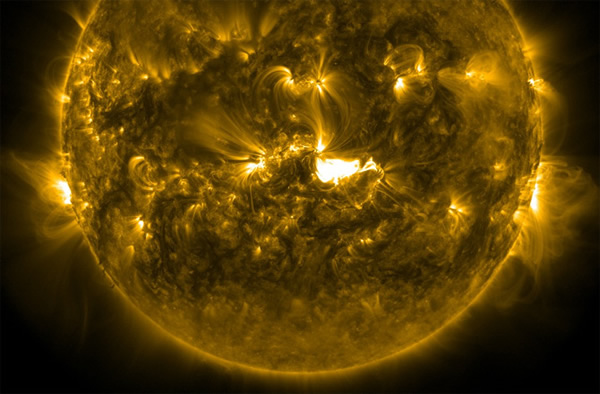Solar Boom: Sun Blasts X-Class Flare Right At Us
The X1-class solar flare erupted from AR 1944 on Jan. 7. The flare also triggered a coronal mass ejection (CME) that is expected to reach Earth on Jan. 9. Space weather forecasters predict a 60 percent chance of a geomagnetic storm when the CME interacts with our global magnetic field.
Yesterday, the sun reminded us that although the current peak of its solar cycle has been a little sub-par, it is still capable of mustering the magnetic energy to erupt with its most powerful class of solar flare. What’s more, it was aiming its sights right at us, prompting a space weather alert.
Solar flares occur deep within the sun’s atmosphere, a region known as the lower corona. This magnetically dominated region is threaded with strong magnetic fields. The region is currently alive with magnetic activity, field lines popping through the sun’s surface from its interior, filled with superheated solar plasma -- beautiful features known as coronal loops.
In some active regions that are often accompanied by highly contrasting dark spots, or sunspots, the conditions can be ripe for magnetic reconnection events. These events can be explosive, and when they occur can unleash vast quantities of energy.
As solar astronomers watched an ominous black patch of sunspot activity (in an active region called AR 1944) rotate toward us over the past few days, there was always a chance that the fizzing region of magnetic instability was going to blow. And blow it did.
NASA’s space-based Solar Dynamics Observatory watched the X-class flare rapidly accelerate the multi-million degree solar gasses, generating an intense flash of light in extreme-ultraviolet wavelengths. The flare was quickly followed by a coronal mass ejection (CME) — a huge magnetic “bubble” of magnetism racing into space, carrying highly energized solar plasma with it. Like looking down a barrel of a gun, Earth is in the cross-hairs and space weather forecasters are predicting the CME will slam into our planet’s magnetosphere within the next couple of days.
As seen by the veteran NASA/ESA Solar and Heliospheric Observatory (SoHO), the flare also generated a very rapid wave of particles that traveled ahead of the CME. As noted by NASA’s Tony Phillips on SpaceWeather.com, these particles hitched a ride on the shockwave the flare generated, causing the particles to hit SoHO’s electronics, generating a “blizzard” of streaks on the acquired images.
Forecasters are predicting that when the CME hits Earth, there will be a 60 percent chance of geomagnetic storms. These magnetic disturbances can affect the whole of Earth’s magnetosphere, sending ripples throughout our global magnetic field. Often, the energetic solar particles contained within the CME will be injected into the magnetosphere’s layers, funneling toward the polar regions, generating beautiful auroral displays as the solar particles rain into the upper atmosphere.
Although our planet is more than capable of deflecting these storms, there can be consequences for our technology. Therefore, satellite operators and companies managing national power grids will be closely watching the increasing radiation environment around Earth. But for the majority of us, it’s an opportunity to see our enigmatic sun throw a temper tantrum and, if you live in high-latitude regions, you may be lucky enough to spot the most beautiful light show on our planet.(Jan 8, 2014 12:32 PM ET // by Ian O'Neill)












